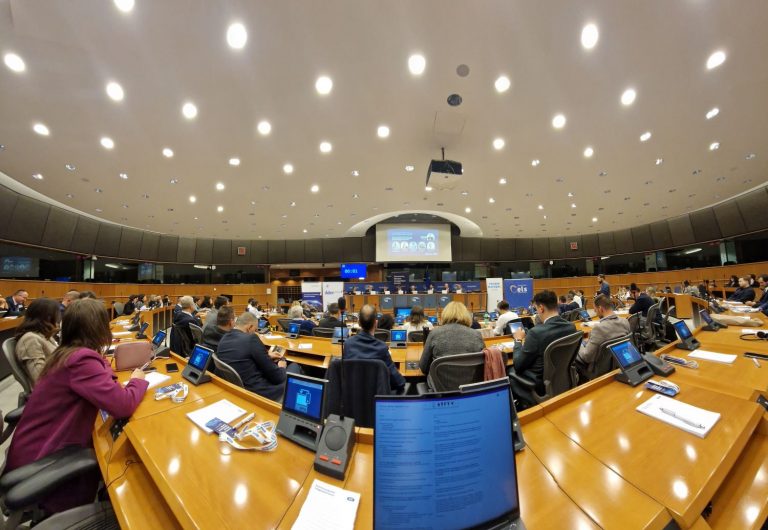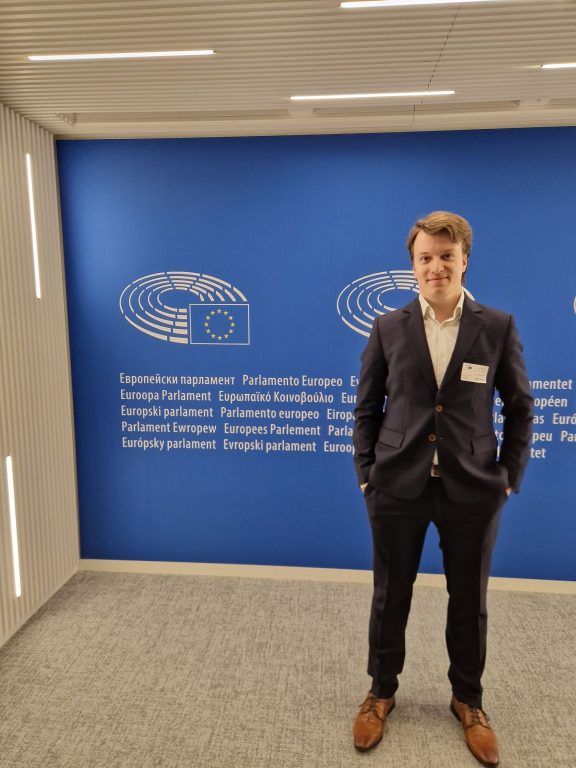
Electricity Market Integration Forum in Brussels
What: Electricity Market Integration Forum
Where: Brussels, Belgium
When: 17th April 2024

Member of LEST, Mr. Jan Jeriha participated on the Electricity Market Integration Forum (EMIF) that took place at the European Parliament in Brussels on 17th of April 2024 and was attended by more than 100 people. It focused on advancing the integration of Energy Community Contracting Parties into the Implicit Electricity Market (IEM). The forum aimed to bridge the gap between EU policies and neighbouring nations, emphasizing implicit electricity market coupling.
The forum featured two pivotal panel discussions, each addressing different parts of market integration:
- Panel discussion: Delivering on the benefits of energy market integration: What political support is needed to facilitate and accelerate implicit electricity market coupling in the region?
- Panel discussion: Will the integration of EnC Contracting Parties provide for a more robust single European market for electricity?
Panel 1: Delivering on the benefits of energy market integration: What political support is needed to facilitate and accelerate implielectricity market coupling in the region?
Opening the first panel discussion, Franc Bogovič (Member of the European Parliament) emphasised the importance of the newly adopted regulations and the initial Electricity Market Integration Forum (EMIF). He outlined three key lessons from the recent energy crisis: the necessity for the EU to build its own supply chains, maintain low carbon emissions, and reduce dependency on undemocratic countries. Bogovič highlighted Slovenia’s successful market coupling as a model for accelerating the integration process across the EU.
Rafael Gomez Elvira Gonzalez (Chairman of the All-NEMO Committee) presented key messages regarding the expansion of electricity market coupling advocating for the extension of implicit electricity market coupling beyond the EU borders as “market coupling is the best way to deliver tangible social welfare to the Europeans”, the inclusion of Serbia, North Macedonia, Albania, Montenegro, and Ukraine will only increase its efficiency and benefits. The projections include the integration of the first Energy Community (EnC) bidding zones into the SDAC/SIDC frameworks by 2026/27, pending the submission and approval of the MCO IP by ACER.
Mechthild Wörsdörfer (Deputy Director-General, DG ENER) emphasized the internal energy market as the cornerstone of EU policy, noting the accepted reform of EU market design and the benefits of electricity market integration like energy security, climate benefits, and affordability.
Artur Lorkowski (Director of Energy Community) remained hopeful on the achievability of the January 1, 2026, deadline for market coupling, highlighting mixed progress across various countries and the essential cooperation required to meet deadlines. He mentioned the Carbon Border Adjustment Mechanism (CBAM), as the unexpected push in 2023 that will not hinder trade between Member states and CP, but present dual challenge. Incentives for market coupling but also the threat of market decoupling if the prerequisites are not secured.
Christophe Gence-Creux (Head of the Electricity Department at ACER) discussed the economic benefits of market integration and that there is no doubt that this extension of market will bring a lot of benefits. He mentioned upcoming tools to estimate social welfare benefits and pointed out significant delays that need addressing to facilitate further integration.
Radoš Popadić (Advisor to the Minister of Mining and Energy of Serbia) shared insights from Serbia’s perspective, detailing the early adoption and technical readiness for market coupling, but also noted delays due to political changes.
Mark Copley (CEO of Energy Traders Europe) reflected on the progress made in drafting the CACM and the collective effort required to advance market integration. He highlighted the significant progress made in market integration, surpassing initial expectations and emphasized the collaborative effort behind these achievements and the need for a continued top-down approach to further reduce trading barriers and enhance market efficiency.
To round-up the session Christian Baer (Secretary General at Europex) asked Mark Copley to try to answer the question: Do we see a fully integrated EU market? He noted the tedious nature of the process but emphasized the potential for enhancing EU competitiveness through an expanded and integrated market, as the EU market is the best performing market in the world, and if you expand it, it should only get better.

Panel 2: Will the integration of EnC Contracting Parties provide for a more robust single European market for electricity?
To open the second panel, Klemen Grošelj (member of the European Parliament) offered an overview of the challenges and opportunities of integrating the EnC CP into the EU’s single electricity market. His insight addressed several key areas:
The influence of the Green Deal, particularly the Emissions Trading System (ETS) and the CBAM, on business models within the energy sector in the EnC CP, was discussed. He acknowledged the significant challenges posed by the reliance on coal power plants, which remain the backbone of the electricity market in the CP. With the transition period running until 2027, he expressed that while the impacts are major, there is still an opportunity for adaptation to meet EU standards, emphasizing the urgency due to the ongoing energy crisis and the necessity for compliance with the ETS.
Highlighting the link between energy infrastructure and geopolitical factors, Grošelj emphasized the importance of careful choices in technology sources and investors. This approach is vital to avoid the risks associated with questionable owners or technologies, especially as energy infrastructure remains a critical component of national security.
Cosimo Campidoglio (Chair, Market Coupling Steering Committee) emphasized the necessity of involving multiple parties in market coupling initiatives. He highlighted the creation of regional projects as crucial for fostering discussions and collaboration not mandated solely by regulation but motivated by local engagement and mutual benefits.
Zvjezdan Vojović (General Director of Directorate for power engineering, Ministry of Energy and Mining Montenegro) detailed Montenegro’s plans for market coupling, which will involve the HVDC connection with Italy. It aligns with recommendations from ACER and the Energy Community to couple through Italy, marking it as a pivotal development for Montenegro.
Simon Shutionski (CEO of MEMO – NM NEMO) presented North Macedonia’s plan and discussed the MoU between North Macedonia and Bulgaria, marking it as the first of its kind aimed at performing market coupling between EnC and EU countries.
In the concluding remarks, Anže Predovnik (CEO of ADEX and BSP) summarized the progress of all EnC CP, which expressed optimism about meeting the integration timelines by 2026, emphasizing the necessity for the parties to align their national legislation with EU standards. He also highlighted the role of the EU Parliament as an ongoing crucial platform for dialogue and development in the electricity market sector. Looking forward, he reinforced the EU forum’s mission and expressed anticipation for continuing these discussions at next year’s forum, projecting confidence in the sustained momentum of these integration efforts.

